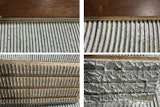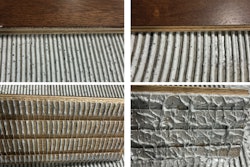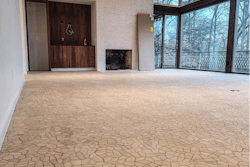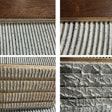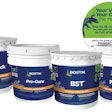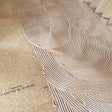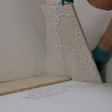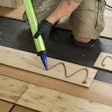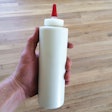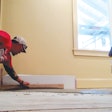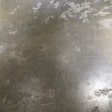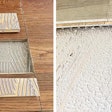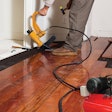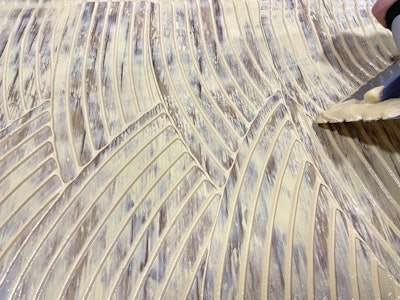
I need to stress that this is not intended to be the “definitive statement on all adhesive chemistry.” Instead, it’s intended as a very simplified, basic explanation for general knowledge, with an emphasis on “basic” so nobody gets too excited about me not detailing specific properties or chemistry of every possible formulation of adhesive (including dry/tape systems)!
There really are three basic types of adhesive chemistry. Understanding these different types should help you understand what each type can and cannot do, and help identify or, better still, avoid installation-related problems. Let’s go over each one.
1) Solvent-based adhesives
The first types are adhesives where a solvent (this includes water) needs to leave the applied adhesive, and what remains is the adhesive as it was designed to perform.
There are “hot-solvent” adhesives, but clearly the most common adhesives here are water-based adhesives. They can be “wet-set” or “dry-set” adhesives. Either way, the water absolutely must leave the material. The moisture content in the air and substrate can greatly affect the dry/cure time of these adhesive types.
A “wet-set” water-based adhesive is almost always going to require an absorbent substrate (the exception being a very “breathable” floor covering, like some carpet). Because the water needs to go somewhere, and it can’t go up and through the floor covering, it must go down into an absorbent substrate. Applying a “wet-set” water-based adhesive over a non-absorbent substrate and then installing a non-breathable floor covering directly over it is just like putting the lid back on the bucket of adhesive.
“Dry-set” water-based adhesives (often referred to as pressure-sensitive adhesives, or “PSAs”) can be applied over both absorbent and non-absorbent substrates, but, again, the water absolutely must leave the product. When the water leaves, the chemical reaction happens, and the solids that remain behind are the adhesive as it was designed. The absorbency of the substrate and the moisture content of the air can affect the dry time significantly, but once all the water has left, the working time is less affected. The remaining “solids” will have a high “tackiness” and are intended to immediately grab and hold the material being installed. These adhesive types can remain permanently tacky or can move to a permanent bond.
These are a favorite type of adhesive for resilient flooring installers in the United States, but they do tend to have lower strength than wet-set water-based adhesives when fully cured.
2) Moisture-cured adhesives
The second adhesive types need to pull something (moisture) into the adhesives to convert from a liquid to a solid state. These are generally referred to as “moisture-cured” and are most commonly a urethane-based or silane-based product.
Both urethane and silane products need to pull moisture from the air or substrate to complete their chemistry and create the reaction that causes them to cure. The moisture available to these types of adhesives can greatly affect the dry/cure of these adhesives. In high-moisture environments they will dry/cure faster, and you will have less working time. In low-moisture environments you will have longer dry/cure times, and you will certainly have longer working times.
Using these types of adhesives to fill voids is typically not the best idea, as both adhesive types will cure fastest from the highest exposure to moisture to the least—in other words, from the outside to the inside. Very heavy or thick applications can greatly reduce the ability for all the applied adhesive to dry/cure, and they can also potentially even stop drying/curing (again, just like putting the lid back on the bucket).
The primary difference between urethane- and silane-based adhesives is the isocyanate cross-linker. Urethane adhesives have an isocyanate as part of their makeup, and when the product takes on the moisture, the isocyanate acts like a “kicker” to the reaction, providing both a chemical and mechanical bond to the substrate and back of the floor covering. A silane-based adhesive does not contain the isocyanate cross-linker, so it just needs the moisture to complete its chemical chain. Silane-based adhesives only bond mechanically, which makes them a bit nicer for installing prefinished products like wood flooring. While they act somewhat similar in many ways, urethane and silane adhesives are chemically quite different.
3) Two-component adhesives
The third type of adhesives are “two-component” adhesives. These will generally be an epoxy- or urethane-based product. Both will have the mass (Part A) of the adhesive mix that is essentially “dormant” until the second component (Part B) is added to the matrix. The addition of the second component, a catalyst/cross-linker, completes the chemical chain and causes the adhesive to “react” throughout the entirety of the mixed product.
Thorough mixing is vital for these adhesive types. They are not really affected by site moisture conditions, as the chemical reaction is happening throughout the entirety of the mixed product regardless of the moisture of the environment. The depth or thickness of application will not affect its dry/cure time.
Within these three basic adhesive types there are virtually unlimited differences in application, coverage, performance, and types of materials that can be installed with each, so always read and understand the technical information and contact your local representative or the technical department prior to installation with any questions.










